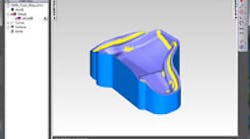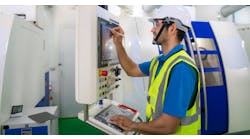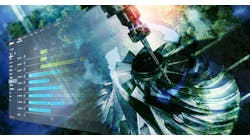Delcam will launch the 2011 version of its FeatureCAM feature-based CAM system at IMTS, which will incorporate a more modern interface, support for 64-bit computers, improved data exchange from a wider range of design software, and new strategies across the complete program, from turning to five-axis machining. All these developments will ensure that FeatureCAM retains the leadership in programming speed and ease of use it has held since its launch in 1995, when it was the world’s first feature-based programming system.
The large number of improvements reflects the increased investment in development of the software since its acquisition by Delcam in 2005. FeatureCAM has also benefited from Delcam’s large investment in areas like data exchange and post-processing that can be applied across the company’s complete family of CAM software.
The most obvious change for existing users will be the new-look interface. This incorporates a more modern style of icon throughout the system, with images that more clearly illustrate the various options. They make the software even easier for new users to learn and for casual operators to use. Users of other Delcam software, such as PowerSHAPE or PowerMILL, will gain the greatest benefit as many of the new icons have been duplicated from those programs.
FeatureCAM 2011 will be the first version to support 64-bit hardware. 64-bit technology removes the memory limitations of 32-bit computers so allowing more efficient toolpath generation, especially for companies machining large or complex parts. User productivity has been further improved by extending the use of the latest multi-threading technologies available in recent hardware. In addition, improved memory management within the software will give faster calculation times, with the greatest benefits again coming when programming larger or more complex components.
The improved data exchange has been achieved by enabling Delcam’s Exchange software to be used as an additional import mechanism so that all the formats supported by Exchange can be imported into FeatureCAM. These include direct translations from systems such as CATIA V5, Siemens NX and Solid Edge, Pro/Engineer, AutoCAD Inventor, SolidWorks and Rhino, as well as support for standard formats like Parasolid, ACIS, IGES and STEP.
The main enhancement for turning is the addition of a new style of finishing that uses separate passes to cut the faces and the diameters of the component. This approach gives a better surface finish, improved tool life and more efficient clearance of the chips generated during the first pass over the part.
Fully-automated de-burring and chamfering is now available when programming 2- or 2.5-axis parts. The ability to incorporate chamfers, even when they were not shown in the original CAD model, was added in FeatureCAM 2010. The automation of this option will allow faster programming of these finishing operations.
Another 2-axis enhancement is the ability to machine parts larger than the travel of the machine tool. If the machine has a table that can index around the Z axis, FeatureCAM can divide the component into pieces and generate the required series of machining operations.
Finish machining of flat areas has been made more efficient with improved detection of these surfaces. FeatureCAM will then automatically add the appropriate extra Z-level into the toolpath to give accurate finishing. This option will be most beneficial when machining a series of pockets with flat bottoms at different heights.
Over recent releases, the milling capabilities within FeatureCAM have been enhanced greatly through the incorporation of strategies from Delcam’s PowerMILL system for high-speed and five-axis machining. This has continued in the 2011 version with the incorporation of Delcam’s patented Race Line Machining strategy into FeatureCAM. With this approach to offset machining, the roughing passes are smoothed out progressively as the toolpaths move further from the main form.
The overall result is a much smoother toolpath that allows the cutter to be used at its optimum feed rate for a much larger percentage of the job. At the same time, the elimination of sudden changes of direction reduces the rapid variations in loading that can lead to cutter breakages and damage to critical machine tool components, including the spindle. In many cases, the total length of the toolpath will also be significantly reduced, with the consequent reductions in machining times and cutter wear.
On the five-axis strategies, more options have been added to the collision avoidance functionality. These will give the user more control over the movements chosen by the software to avoid potential problems and so will help to reduce sudden changes in direction.
The 2011 release also includes improvements in the more fundamental process of five-axis drilling, with new options to program and edit five-axis hole creation, even when the items are supplied as simple circles in space rather than fully-defined solids.
Users of five-axis equipment will also benefit from improved simulation capabilities. These enhancements will make it even easier to check programs on the computer before they are sent to the machine tool.
Finally, programming of wire EDM has been improved with the ability to work directly from solid models in a similar way to FeatureCAM’s milling, turning and drilling options. In addition, a new automatic ordering command will make it easier to combine operations needed to produce different features, while improved control over retract moves will simplify the programming of 4-axis wire EDM equipment.
Related Articles
[IMTS Preview] Delcam to Show 64-bit PowerMILL Software
[IMTS Preview] Delcam to Launch New Feature-Based CAM






